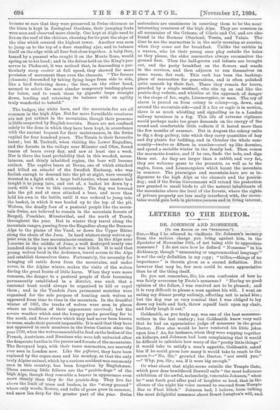ANIMALS OF THE ALPS.
IN the Field of November 3rd, Mr. W. Baillie-Grohman gives an interesting account of the bouquetins, or Alpine ibexes, probably the rarest of all European animals, except the beaver and the lynx,—the latter, strange to say, being still found from time to time in one or two of the largest forests of the Alps. Except for the tradition of chamois hunting, the English, who crowd every year to Switzerland seem curiously indifferent to the wild life of the mountains. Mr. Ward Fowler, who in his "Year with the Birds" gives a charming account of the migration of the birds which he watched ascending the Splfigen pass, declares that he has never met a single Englishman in his mountain walks who had a special interest in the birds of the Alps, and that though the guide-books have something to say of the geology and botany of the mountains, they give little or no attention to their fauna. In this relation the preservation of the ibexes, and their reappearance on the Swiss side of the Alps, is perhaps the most interesting recent event in the natural history of the mountains. If it were not that the pas- sion for ibex-hunting, common to every peasant of the Valais and of Piedmont, was also shared by the late Victor Emmanuel, it is probable that the animals would by this time have disappeared from their last refuge in the Piedmontese Alps. None were seen in the Valais after 1809; but as early as 1869, P. de Tschudi, in his admirable work, the "Monde des Alpes," noted that they were crossing the summit of the Piedmont range, and once more visiting Monte Rosa, where they had not been seen since 1775. Mr. Baillie-Grohman accounts for the reappearance of the ibexes in Switzerland as follows. In 1821 the naturalist Zummstein persuaded the Piedmonteae Government to pass a law pro- tecting a small colony of ibexes which still survived in the heart of the Graian chain. These were probably the very last of their race, for those in the Zillerthal mountains, which until the middle of the last century were protected by the Archbishops of Salzburg, had all disappeared. The Pied- mont herd was protected by Zummstein's law, until Victor Emmanuel determined to preserve the ibexes in a more thorough manner "His first step was to acquire in 1858 from the communes of Cogne, Val Savranche, Champorcher, and Bomboset their exclu- sive shooting rights, to which, in 1863, he added those of Cour- majeur, which extended along the Italian (or southern) slopes of the Mont Blanc chain. Roughly speaking, the ground so acquired covered an area of about one thousand square miles, and was guarded by fifty or sixty carefully selected keepers. It is said that there were not fifty of these animals left in this territory when the King took it over. When he died in 1878 the head of game was computed to be from five hundred to one thousand animals, and for the previous ten years he had annually killed forty or fifty males, the shooting of females being an offence in the eyes of this good sportsman which he never forgave or forgot."
As the present King of Italy does not inherit his father's enthusiasm for ibex-shooting the herd continues to increase, and the male ibexes, no longer victims to Victor Emmanuel's rifle, are leading their families in increased numbers into further and distant mountains, where they have not been seen for generations. Should the Swiss, who now protect all wild- birds by strictly enforced legislation, decide to extend to the ibexes the protection which they enjoy in Piedmont, the climbers in the Alps would enjoy the sight of a creature which is not only beautiful in itself, but surpasses even the chamois in its astonishing powers of mountain-climbing. It gallops up, over, and down the cracks and precipices of ice or rock, like a greyhound on the flats of Altcar ; and the ancient legend, that it jumped down precipices, and alighted on its curved-horns, to break the fall, is a very natural invention to account for feats which were seen, but seemed inexplicable by any credible use of legs and feet. When the bouquetine
became so rare that they were preserved in Swiss chateaux as the bison is kept in Zoological Gardens, their jumping feats were seen and observed more closely. One kept at Aigle used to live on the roof of the chateau, choosing for its post the slope of the tiles which covered the highest tower. Another was seen to jump on to the top of a door standing ajar, and to balance itself on the edge with all four feet close together. A baby ibex, Lamed by a peasant who caught it on the Monte Rosa, would spring on to his head ; and in the drives held on the King's pre- serves in Piedmont, it was noticed that, in descending a par- ticularly steep conloir at full speed, they showed far more precision of movement than even the chamois. "The former [chamois] descended by taking flying leaps from side to side, like a bird flattering down ; the ibex, on the other hand, seemed to select the most slender temporary landing-places far below, and to reach them by gigantic leaps straight down, landing and retaining its balance with an agility truly wonderful to behold."
The badger, the white bare, and the mountain-fox are all common in the high Alps. But far more formidable creatures are not yet extinct in the mountains, though their presence is little suspected by English tourists. Bears are not confined solely to the dens in which they have been kept, in accordance with the ancient bequest for their maintenance, in the Swiss capital for four hundred years. The Tessin is their favourite haunt ; but M. Tschudi, when visiting the Lower Engadine, and the forests in the valleys near Munster and Of en, found traces of bears every day, and saw at least one a week. Nor is there the least probability that in this wooded, moun- tainous, and thinly inhabited region, the bear will become extinct. The captive bears at Berne, one of which attacked and killed an attache of the Swedish Embassy, who was foolish enough to descend into the pit at night, were recently worsted in a fight with a large bull-terrier, whose master had taught it to jump into, and out of, a basket let down by a cord, with a view to this encounter. The dog was lowered into the pit and at once attacked a bear, and more than held his own in the battle, until it was ordered to jump into the basket, in which it was hauled up to the top of the pit. Wolves, the deadly foes of a pastoral people like the moun- tain Swiss, are believed to remain in the mountain forests of Bergell, Puschlav, Mansterthal, and the north of Tessin throughout the year. But in winter they travel along the mountain ranges, passing from the Engadine along the Bernese Alps to the plains of the Vaud, or down the Upper Rhine along the chain of the Jura. In hard winters stray wolves ap- pear even in the less mountainous cantons. In the Alps near Lucerne in the middle of June, a wolf destroyed nearly one hundred sheep in a week before it was killed. It is said that young wolves bred in the Ardennes, travel across to the Alps and establish themselves there. Fortunately, the necessity for bringing all cattle down from the mountains, and under cover, in the Alpine winter, makes the visits of the wolves during the great frosts of little harm. When they were more common, the danger to a pastoral people of their becoming permanently established in a district, was such that a cantonal hunt could always be organised to kill or expel them ; and in the Vaudois Jura permanent societies were organised for the sole purpose of hunting such wolves as appeared from time to time in the mountain. In the dreadful winter of 1881, the tracks of wolves were seen in places where no tradition of their appearance survived ; but the severe weather which sent the hungry packs prowling far to the south, and froze rivers which they had never been known to cross, made their pursuit impossible. It is said that they have not appeared in such numbers in the Swiss Canton since the year 1799, when the wolves assembled to feed on the bodies of the French, Austrians, and Russians who were left unburied after the desperate battles in the passes and forests of the mountains. The Savoyard boys, with their tame marmottes, are scarcely ever seen in London now. Like the pifferari, they have been replaced by the organ-man and his monkey, so that the only truly Alpine animal, which by a curious accident was commonly seen in this country, has been forgotten by Englishman. These amusing little fellows are the " prairie-dogs " of the high Alps, though they resemble a beaver in appearance even more closely than they do the prairie-dog. They live far above the limit of trees and bushes, in the "stony ground" where only weeds, flowers, and tufts of grass grow in summer, and snow lies deep for the greater part of the year. Swiss
naturalists are unanimous in asserting them to be the most interesting creatures of the high Alps. They are common in all mountains of the Grisons, of Glaris and Uri, and are also found in the Bernese Oberland, Tessin, and Valais. The time to see the marmottes is in the early morning at sunrise, when tkey come out for breakfast. Unlike the rabbits in a warren, who let their young ones play outside the holes- as they please, the older marmottes always reconnoitre the ground first. Then the half-grown and infants are brought out, and the party breakfast on the flowers and weeds in the crevices, and then adjourn to sun themselves on some warm, flat rook. This rock has been the basking- place of marmottes for generations, and is often polished quite smooth by their feet. There they remain for hours, guarded by a single sentinel, who sits up on end like the prairie-dog vedette, and whistles at the approach of danger- in the shape of fox, eagle, Lammergeier, or man. The cry of alarm is passed on from colony to colony—up, down, and, around the mountain-side—and if a fox or eagle is in motion,. there is as much whistling and signalling as in a London railway terminus in a fog. This life of extreme vigilance- would perhaps make too great demands on the energy of the round and comfortable little rodents if it lasted more than- the few months of summer. But in August the colony unite to dig a deep gallery, into which they carry quantities of hay and dry plants for bedding, and in October the whole com- munity—twelve or fifteen in number—curl up like dormice,. and spend a sociable winter in the family bed. Then comes the marmotte-hunter, and if he can, finds the hole, and digs them out. As they are larger than a rabbit, and very fat,. they are welcome game to the peasants, as well as to the eagles, foxes, and Lammergeiers which haunt the mountain in summer. The ptarmigan and mountain-hare are as in-- digenous to the high Alps as the chamois and the prairie- dog ; and if the Swiss Government will extend the protection now granted to small birds to all the natural inhabitants of the mountains above the level of the forests, where the rights. of private property are less easily interfered with, the moun- tains would gain both in picturesqueness and in living interest.



















































 Previous page
Previous page